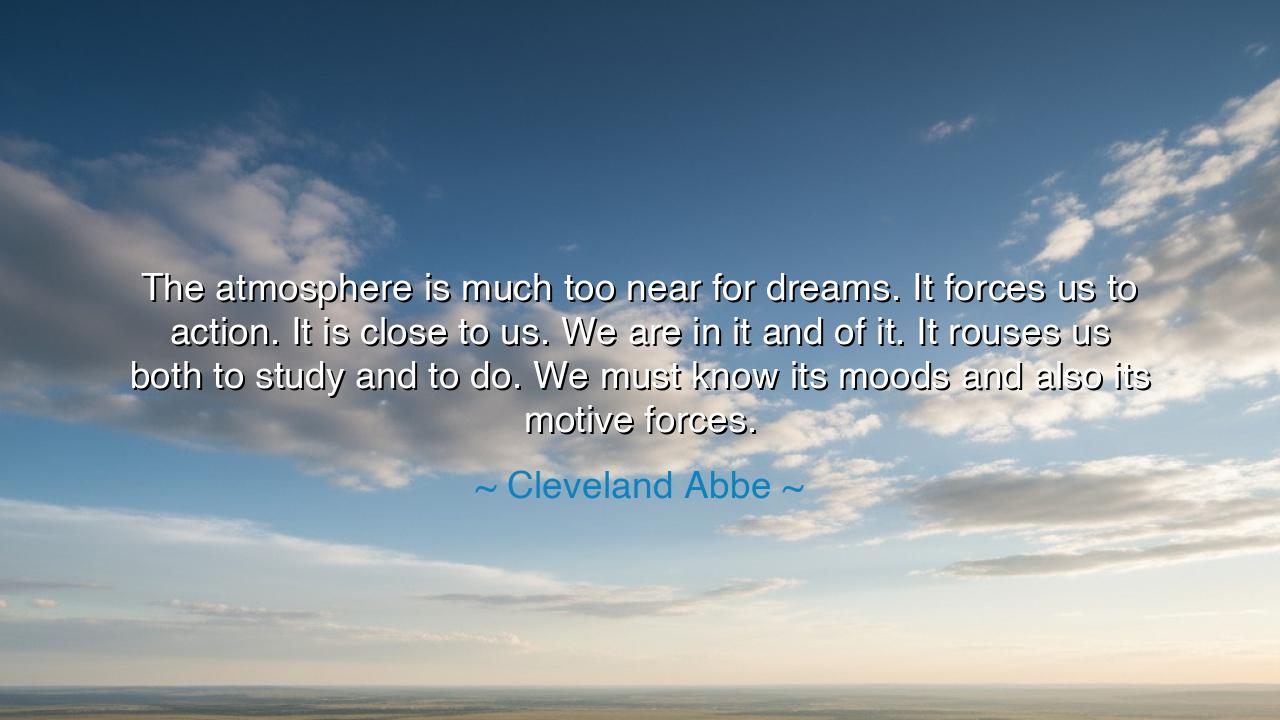
The atmosphere is much too near for dreams. It forces us to
The atmosphere is much too near for dreams. It forces us to action. It is close to us. We are in it and of it. It rouses us both to study and to do. We must know its moods and also its motive forces.






Hearken, children of the earth and sky, and attend to the words of Cleveland Abbe, a sage of the heavens and master of the elements: “The atmosphere is much too near for dreams. It forces us to action. It is close to us. We are in it and of it. It rouses us both to study and to do. We must know its moods and also its motive forces.” Pause upon these words, for they reveal a profound truth that bridges observation and responsibility: the natural world calls not for idle wonder alone, but for engagement, understanding, and action.
Abbe begins with the recognition that the atmosphere, though ethereal and vast, is intimately entwined with human life. It is not a distant abstraction, but a force in which we dwell, breathe, and act. Dreams alone cannot navigate its currents; one must study, measure, and respond. Here lies a timeless lesson: proximity demands attention, and the forces that surround us—whether air, water, or society—require both understanding and response.
History offers mirrors of this principle. Consider the sailors of ancient Phoenicia, who navigated the seas by observing the winds, clouds, and currents. Their survival and prosperity depended upon knowing the moods of the sky and the motive forces behind storms and tides. Just as they could not afford to dream idly of distant lands, so too must humans today observe and respond to the atmosphere, interpreting its signals with wisdom and skill.
Even in modern times, Abbe’s insight resonates in the work of meteorologists and environmental scientists. Understanding weather patterns, forecasting storms, and preparing for natural disasters are not acts of idle curiosity; they are essential interventions in the service of life. The atmosphere, close to us and entwined with our existence, commands respect, observation, and action—a principle that extends beyond science to all realms where forces surround and shape our lives.
The essence of Abbe’s reflection lies in the marriage of study and action. Knowledge without application is incomplete, and engagement without understanding is perilous. The ancients taught that the wise not only contemplate the heavens and the earth but also act upon that understanding to safeguard, to cultivate, and to create. Abbe reminds us that the study of the atmosphere, and of nature itself, is inseparable from the duty to act responsibly upon its truths.
Practical wisdom emerges from this reflection. Observe the world with attention and curiosity, but do not stop there. Measure, analyze, and respond. Whether predicting the weather, managing resources, or navigating human affairs, recognize that proximity and knowledge demand action. The moods and motive forces of the world are guides, not merely objects of speculation—they compel engagement, preparation, and foresight.
Moreover, this insight carries a broader lesson about responsibility. Humanity is in the forces that shape the world, entwined with their rhythms and consequences. To ignore, to dream passively, is to invite disaster; to observe and act with understanding is to honor life and sustain the balance between human endeavor and natural law. Abbe’s counsel transcends meteorology—it speaks to every field where awareness and responsiveness are vital.
Therefore, generations to come, remember Cleveland Abbe’s wisdom: the atmosphere is too near for dreams alone; it forces us to action. Study its patterns, understand its forces, and respond with diligence and care. In doing so, you honor the intricate dance of nature, cultivate foresight and resilience, and fulfill the enduring mandate that knowledge must always be wedded to action, observation to response, and contemplation to the stewardship of life.
If you wish, I can also craft a more poetic, mythic version of this reflection, portraying the atmosphere as a living, breathing entity that guides and challenges humanity, suitable for meditative or heroic narration. Do you want me to do that?






AAdministratorAdministrator
Welcome, honored guests. Please leave a comment, we will respond soon